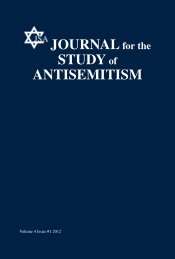Journal for the Study of Antisemitism
Journal for the Study of Antisemitism
Journal for the Study of Antisemitism
You also want an ePaper? Increase the reach of your titles
YUMPU automatically turns print PDFs into web optimized ePapers that Google loves.
152 JOURNAL FOR THE STUDY OF ANTISEMITISM [ VOL. 1:139<br />
bias, as well as by <strong>the</strong> fatigue factor that sets in during coverage <strong>of</strong> such a<br />
protracted conflict. 48<br />
Over much <strong>of</strong> <strong>the</strong> past decade, <strong>the</strong> Palestinian Authority (PA) has<br />
adeptly depicted its constituents as dispossessed and oppressed–effectively<br />
eliciting widespread sympathy by way <strong>of</strong> effective sound bites and poignant<br />
images. “You cannot shoot our children and get away with it?” exclaims PA<br />
spokeswoman Hanan Ashwrawi in perfect English. Negotiator Saeb Erekat<br />
decries <strong>the</strong> “daily massacre <strong>of</strong> Palestinians by Israel.” 49 The message thus<br />
becomes, how can Israel want peace when its mighty army sends tanks<br />
against impoverished stone-throwers?<br />
Israel, on <strong>the</strong> o<strong>the</strong>r hand, has <strong>of</strong>ten assumed a defensive position–that<br />
its military responses have been due solely to physical provocations and out<br />
<strong>of</strong> <strong>the</strong> need <strong>for</strong> security. It has been slow to present in clear and simple<br />
ways what many consider its best arguments: that it has been under siege by<br />
Arab countries and movements <strong>for</strong> more than half a century. It has been<br />
unable to focus attention on how <strong>the</strong> Palestinian leadership employs both its<br />
educational system and its communications media as tools <strong>of</strong> incitement; on<br />
how rock-throwing teenagers sometimes serve as camouflage <strong>for</strong> machinegun-firing<br />
militia; and on how PA ambulances are used as command-andcontrol<br />
vehicles to deliver troops and weapons to demonstration sites. 50<br />
“Terrorists” v. “Militants”<br />
Perhaps <strong>the</strong> single most problematic choice <strong>of</strong> words in Mideast journalism<br />
concerns those used to describe <strong>the</strong> perpetrators <strong>of</strong> violence that<br />
takes place frequently against non-combatants in Israel and elsewhere. Particularly<br />
troublesome are <strong>the</strong> terms “terrorist,” “militant,” and “extremists<br />
on both sides”–all <strong>of</strong> whom are said to contribute to a “cycle <strong>of</strong> violence,”<br />
which itself is a phrase that strongly implies equivalency.<br />
Terrorist attacks against Israeli citizens are <strong>of</strong>ten treated differently by<br />
<strong>the</strong> media than are similar atrocities committed against o<strong>the</strong>r nationalities.<br />
48. For examples <strong>of</strong> alleged “moral equivalency” in Middle East reporting, see<br />
C.A.M.E.R.A. at http://www.googlesyndicatedsearch.com/u/camera?domains’camera.org&sitesearch’camera.org&q’moral+quivalency.<br />
49. See Stephanie Guttmann, “Lights, Camera, Intifada: The Violence in <strong>the</strong><br />
Mideast Has Become a War <strong>of</strong> Images, in Which <strong>the</strong> Press Is <strong>the</strong> Key to Victory,”<br />
The Weekly Standard, January 1, 2001, p. 26.<br />
50. See, e.g., Larry Derfner, “Tit <strong>for</strong> Tat, Mr. President,” Jerusalem Post, July<br />
30, 2009, p. 15; Gershon Baskin, “Creating a Culture <strong>of</strong> Peace in Israel and Palestine,”<br />
Jerusalem Post, April 8, 2008 at p. 15; and Yaakov Katz, “Haniyeh Operated<br />
Command Center Inside Shifa Hospital,” Jerusalem Post, April 23, 2009 at p.<br />
3.














